Content
- Study history
- Definition
- Classification
- Inner speech
- External speech
- Specifications
- Effectiveness
- Comprehensibility
- Pithiness
- Expressiveness
- Functions and role
- Research methods
- Video about speech in psychology
The definition of speech depends on the context and the scope of interpretation. The ability of people to speak is a landmark and an object of research for many disciplines with varying degrees of interconnection. Speech can express the characteristics of a person's personality and serve as an indicator of physiological processes. The beginning of psychology as a systematized science of our time was laid in the 19th century, although the first attempts to comprehend the mechanisms of speech and thinking were made even before our era.
The direction finally developed in the XX century. In parallel with this, studies of the brain and the functions of its individual parts were carried out. The combination of medical and psychological discoveries made it possible to engage in in-depth study of speech.
Study history
The French scientist Paul Broca, who specialized in the study of the functions and structure of the human body, in the 19th century. drew analogies between pathologies of certain areas of the brain and speech disorders. Thus, the area responsible for the ability to speak coherently was discovered. Brock's area complements Wernicke's area, thanks to which a person learns written and spoken language.
According to modern research, the temporal lobe is also involved in the process of thinking. German neuropathologist and contemporary of Paul Brock Karl Wernicke was looking for a connection between various ailments and injuries cerebral cortex, among the merit of the scientist is the first detailed description of aphasia (pathology, including speech disorders) and its reasons. Later, the German professor Ludwig Lichtheim was also engaged in the study and classification of this ailment.
Studies of the brain have indicated the anatomical causes of speech impairments, but this did not satisfy the consideration of speech impairments as a higher mental function. English neurologist John Hughlings Jackson described oral verbal communication as a complex hierarchy dynamic processes that depend both on the activity of consciousness and on reflexes, habitual reactions and subconscious.
Jacksonian neuropsychologist Henry Head argued that localization and physiological justification of speech-related ailments is only suitable for explaining symptoms, but cannot define it functioning.
The in-depth study of speech as psychology developed was preceded by research by linguists who were also interested in the dependence of speaking on the mind and the pathologies associated with it.
Ukrainian philosopher and linguist Alexander Afanasyevich Potebnya wrote the book "Thought and Language" back in 1862. Among the prominent scientists of this direction, who at different times showed interest in aphasia, were Lev Vladimirovich Shcherba, Ivan Alexandrovich Baudouin de Courtenay, Vasily Alekseevich Bogoroditsky, Ferdinand de Saussure and Roman Osipovich Jacobson, who defined language as a dynamic system.
One of the most common definitions of speech is communication through language. Advances in the study of the issue were also in the environment of psychology, which paid great attention to verbal communication in the first half of the XX century. These studies formed the basis of speech as one of the areas of general psychology.
Further study of verbal communication has led to the creation of a number of specialized disciplines. For example, the Soviet psychologist-neuropathologist Alexander Romanovich Luria, combining the developments of psychology and neurology, founded neuropsychology - the science of the relationship between mental processes and brain activities.
Connecting it with the linguistic structuring and characteristics of speech, Luria laid the foundation for neurolinguistics, which studies the activity of the brain during verbal communication. The development of psycholinguistics as a science of the patterns of formation and understanding of speech was facilitated by the American semiotic linguist Thomas Sebeok and psychologist Charles Edgerton Osgood.
Definition
Sergei Leonidovich Rubinstein, the founder of the psychology of the USSR, who wrote works fundamental for the direction in the 40s. XX century. Initially, he called speech a language acting in the context of an individual's consciousness, while comparing its relationship with language with the discrepancies between individual and social consciousness, respectively.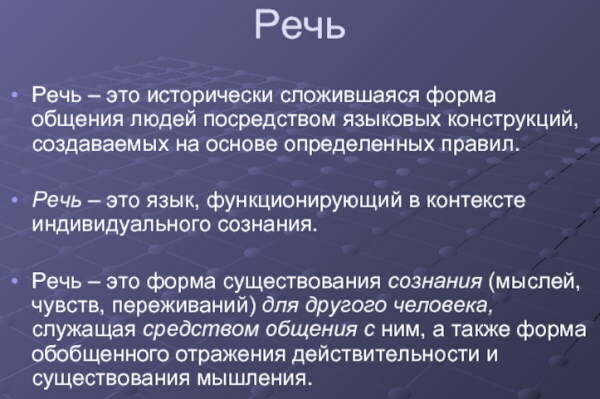
Later, the definition of verbal communication according to Rubinstein was a conscious way of communication and influence, which is based on its semantic meaning. It is a means of expressing the mind, its interaction with the "other" and a generalized reflection of reality.
According to the definition of a psychologist, only that which had content and material meaning as a visual image, gesture, sound and similar carriers deserved a speech characteristic. The scientist was of the opinion about the superiority of thinking over speech.
The work of S. L. Rubinstein was preceded by the works of the Soviet psychologist Lev Semenovich Vygotsky, which were of great importance for speech research. He identified the areas of the brain responsible for communication as part of the dynamic structure that provides the processes of its activity. Vygotsky's approach, who presented speech as an integral concept of psychology, was based on understanding it as one of the highest mental functions. The scientist divided them into cultural and natural.
While the former include and act with the use of artificial means, stimuli and signs, the latter do not require them. According to the results of Vygotsky's research, speech – this is one of the basic mental functions of a cultural form of behavior. She and thinking are different processes with a close relationship. Speech cannot be a mirror expression of thinking, however, the thought contained in speaking is transformed, receiving a social form.
The outstanding imperial and Soviet physiologist Ivan Petrovich Pavlov, who laid the foundations for the study of higher nervous activity, defined speech not only as a means of communication. The professor characterized her as a higher behavioral regulator, as well as a way of detailed assessment and synthesis of reality.
Based on the works of Pavlov, A. R. Luria assigned speech one of the main roles in the formation of mental activity. The psychologist defined verbal communication as a means of transforming and transmitting thoughts using a language that encodes relationships, signs, objects or actions for the exchange of information and its integration.
The Soviet psychologist Daniil Borisovich Elkonin, who contributed to the emergence of the theory of activity, called the speech a tool that a person learns to use in the same way as, for example, the use of dishes or tools for letters. The position of the scientist is that the basics of mastering this method of communication are formed in the process of education and depend on its conditions.
Speech in psychology is a universal topic, not only for the various currents of this movement. It is an interdisciplinary object that has many definitions from representatives of various fields of science. In its context, there is no one generally accepted characteristic, since they are created on the basis of the subjects of study.
Some of the disciplines and their areas of study and description of speech:
| Natural Sciences | Humanitarian sciences |
Medicine.
|
Philosophy of Consciousness and Language |
| Physiology | Linguistics.
|
| Anatomy | Philology |
Biology.
| |
Physics.
|
Classification
One of the key works on the analysis of verbal communication is the book by L. WITH. Vygotsky's Thinking and Speech, released at the dawn of Soviet psychology in 1934. In this work, speech is divided into internal and external. Both use visual, sound, or tactile imagery as a guide. The first is formed on the basis of the second and is not intended for communication, while the function of the second is carried out in several ways.
Inner speech
The inner speech of a person is used when thinking, the emergence of plans and intentions.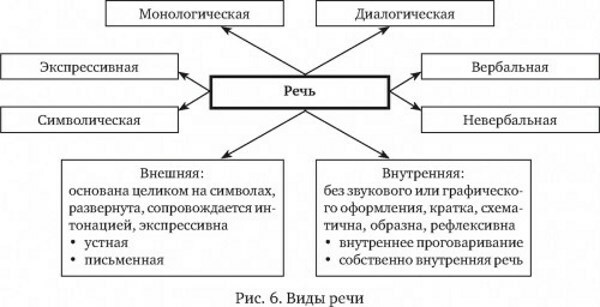
Its main difference is the absence of dubbing, it is divided into 2 types:
- with speaking in the mind;
- without him.
In inner speech, as a rule, there are rarely obvious secondary members of the sentence, the mind simply skips them. For this, it is also called "rolled". A mentally spoken version of internal speech is built according to a structure similar to its external type.
External speech
External speech is written and oral, the latter is also divided into monologue and dialogical. The monologue is carried out by one person. It is one of the most ancient types of communication and is characterized by continuity, validity, literacy and consistency. In the process of a monologue, expressiveness is of great importance, gestures and facial expressions are in demand.
It is of the following types:
- speaking in front of a camera or microphone;
- speech, the purpose of which is usually to evoke some kind of feeling or reaction;
- oral narration about what is known, heard or seen.
- a report carrying a specific message or a generalization of the material presented.
Monologues differ in the complexity of the conduct and preparation that all types of monologues require.
The dialogical type of communication is less demanding on the clarity and completeness of statements. Speech inaccuracies are not so noticeable during dynamic contact. 2 or more people directly participate in the dialogue, supporting it by the very process of communication.
The secondary means of such communication are:
- intonation;
- facial expression;
- gesticulation;
- timbre of voice.
Participants in the dialogue can also observe something together. One of its signs is a discussion of the current situation, state of affairs, or anything that appears in general reality. A conversation is a dialogue on a topic. Its usual purposes are the exchange of information, the definition of competence, the effect on the interlocutor, persuasion or suggestion to him of something.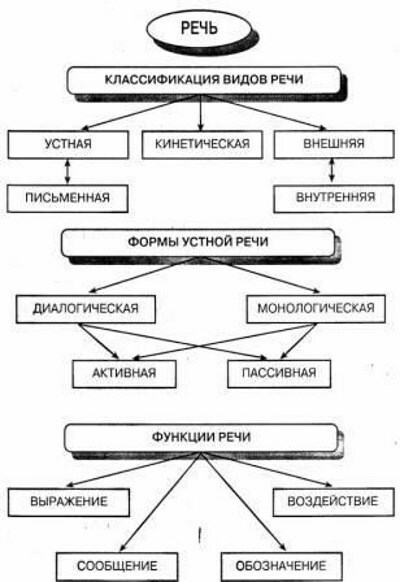
A separate type of external speech is written communication. It was later used verbally. One of the basic purposes of a letter is long-term storage of information. This type of communication has no secondary means of expression other than syntax and punctuation. Written speech is used as one of the ways to get acquainted with world cultures; it is often intended for public use.
Specifications
One of the outstanding experts of the USSR in the field of speech psychology, Professor Vladimir Alekseevich Artyomov, who led the corresponding department of the Moscow State Linguistic University, indicated the properties of the object of study among the main issues of the direction in the period from 1917 to 1957 G.
Key speech characteristics include:
- impact;
- comprehensibility;
- meaningfulness;
- expressiveness.
Effectiveness
The degree of the impact of speech is due to its internal logic, clarity and accessibility. This property is used in education, command, propaganda, educational process, propaganda and agitation.
When the meaning of the speech matches the needs and interests of the listeners, it can strengthen their ideology, provide them with motivation and inspire them to take certain actions. Impact is designed to work with beliefs, attitudes, thoughts, will, emotions, and behavior. Its effectiveness largely depends on the sincerity and commitment to the ideas of the speech of the speaker himself.
Speech in psychology is a method of influence, including phonetic, lexical and grammatical means.
It is used for the following needs:
- Coaching - it is characterized by concise, specific and well-founded recommendations that cannot be interpreted otherwise. Speeches of this type have strict content, sequence and description of ways of performing practical actions in the area under consideration. Instructions may include safety guidelines and a schedule.
- Tips serve as a guide to action for people in states of indecision, hesitation, in the absence of a plan of action and vision for the further development of the situation. To reinforce their rationality and correctness, intonation is used.
- The command contains only the action itself, to the execution of which it calls. This concise type of speech is especially in demand in study and training, providing emotional uplift, confidence and motivation with its intonation. Commands are distinguished by clarity, audibility, intelligibility and calm tone. Their effectiveness depends on the awareness of the audience with the content and nuances of the execution.
- Orders are similar to command action and are designed to directly influence the will of the listener, requiring specific actions. They stand out for their brevity, clarity and self-explanatory. Pronouncing and executing orders implies participation in command-subordinate relationships. They are given additional strength by energetic intonation, and an indefinite mood is also often used. The order serves as a manifestation of will, and its tone does not tolerate objection.
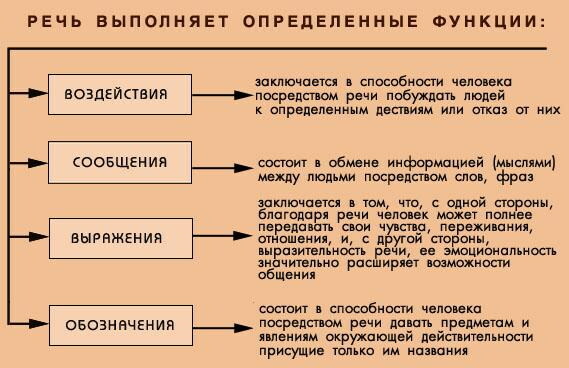
- The request, the purpose of which is to satisfy the listener of the specific needs of the applicant, may have a different form and phonetics. It is usually reinforced with additional words such as "be kind" or "please." A wide range of intonations permissible for a request can both express the need of the applicant or a call to satisfy it, as well as his relationship with the interlocutor.
- The lesson often includes elements of description, explanation, characteristics of advantages and disadvantages, as well as the consequences of the discussed act or phenomenon. Speech of this type is based on real-life examples, expressing positive or negative judgments of the speaker. Instructions affect the attitude of the listener, can call for certain behavior or actions in specific situations. The teachings have a calm, authoritative, and confident tone.
Comprehensibility
This feature depends on the listener's competence in the issue under discussion, his knowledge of the specifics of the topic, the corresponding definitions and manner of speech. The latter is formed in separate areas of activity for the convenience of their discussion. Some terms can overlap with their meanings in other disciplines, which makes speech even less understandable for the interlocutor unfamiliar with the topic. The meaning of the definitions is determined by the context of the conversation.
Speech becomes easier if it includes a small number of specific definitions and consists of short sentences. Their syntactic structure should focus on the topic of discussion. To emphasize the meaning, pauses in the right places and logical stress in words are also used.
Pithiness
Any speech has some kind of content, since its purpose is to convey a specific thought to the listener or personally verify something. Its saturation is due to the realism, significance, depth and number of intentions, thoughts, motives or emotions inherent in it. Minor or mediocre feelings and thoughts make speech as poor as when there are few of them.
Saturation also depends on the speaker's competence in the issue under discussion, his knowledge of the terms, his vocabulary and the ability to use it, including for conveying specific information. A speech in which a topic is thoroughly and thoroughly disclosed can also be called meaningful.
Expressiveness
This property depends on the feelings invested in communication.
The colorfulness and energy of speech are provided by:
- focusing attention;
- clarity of pronunciation;
- correctly chosen intonation;
- grammatical techniques.
Speech in psychology is a means of communication, thanks to the emotional shade of which the same information can convey different feelings and attitudes. The absence or a small number of feelings, on the contrary, makes her dull and lethargic. The expressiveness of speech also changes depending on the use of metaphors, similes, diminutive and petting forms, epithets and the choice of pronouns.
Functions and role
The eminent German and American linguist psychologist Karl Buhler defined the following functions of speech:
- impressive - consists in verbal influence on the interlocutor;
- expressive - designed to express feelings and impressions;
- cognitive - characterizes authenticity.
The number and purpose of the functions of speech in modern psychology depends on the direction and its purpose.
The following set is common:
- speech as a means of thinking;
- speech as a communication tool.
Both classifications provide separate communication processes.
Speech in the form of an instrument of mental activity has the following subfunctions:
- generalization - words are used for classification by underlining features;
- signaling - the connection of individual words with their meaning and presentation, which distinguishes human communications from animals.
Speech as a communication mechanism in psychology is responsible for various aspects of communication.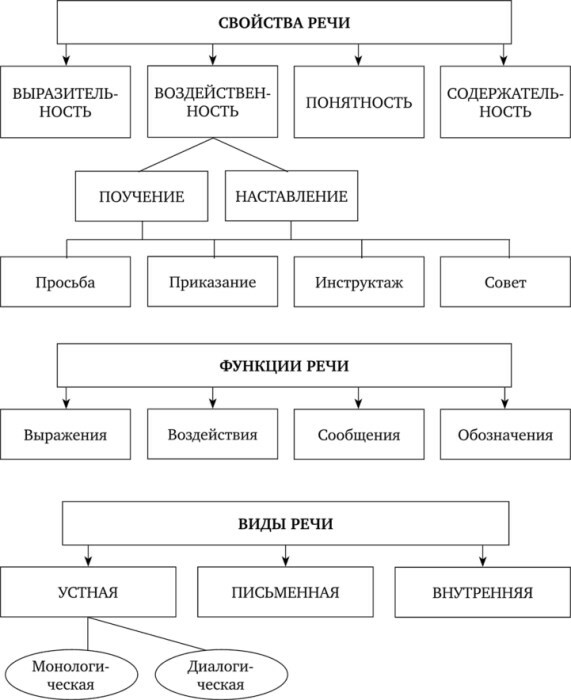
This includes the following sub-functions:
- signaling - provides understanding;
- expressive - includes facial expressions, gestures, intonation and similar additional means of conveying information;
- communicative - represents information exchange;
- significative - provides designations;
- cognitive - familiarization with the subject of speech before the subsequent signification;
- expressive - endows speech with feelings and expresses an attitude;
- influencing - speech influence, together with expression, which is one of the basic subfunctions of speech as a communication mechanism.
Research methods
Speech in psychology is a form of manifestation of thought, as well as a process that affects and integrates any mental activity. The most common method of her research is association tests. They determine the connections between the meaning and the meaning of words, evaluating the time and content of the reaction. The first serves as an indicator of the speed of primary nervous activity, and the second as a criterion for the intensity of the processes of association and the emotional state of the subject.
These experiments allow us to evaluate the features of associations and the dynamics of the thinking-speech function, they include the following methods:
- Paired research allows identifying of the two subjects, associations prevailing in terms of speed and dominance. To do this, both subjects are simultaneously given a stimulus to which they respond out of turn with any words that come to mind.
- Free research, pioneered by the Swiss psychiatrist Carl Gustav Jung, is similar to the paired method. In the process, the subject must respond to the stimulus with any word that comes to mind as quickly as possible. This allows one to assess his dynamics of feelings, motivation and attitudes.
- Study of the skill of written communication. Literacy, clarity of presentation, intelligibility of handwriting and other experimental criteria reveal the nuances of mental and mental development.
- Chain research measures the number of emerging associations in a certain period of time without taking into account their latent formation. For this, the subject says any words, not taking into account their environment. The evaluation criteria are the individual and average statistical sizes of semantic nests, their number and the length of the associative series. The norm is 3-4 nests per minute with 5-6 words each.
- Sydney Levy and Joseph Sachs' unfinished sentence methodology defines a person's attitude towards to himself, the world around him, the peculiarities of his behavior, as well as the nature of his work, partnership and family connections.
- Directed exploration implies a response to a stimulus with an association in accordance with given conditions. For this, the process is given a specific semantic direction, the selected word is usually a synonym or definition related to the content of the instruction. This experiment shows the level of development of speech, the norm is the absence of exceptions in satisfying reactions.
- The study of the semantic differential makes it possible to assess the emotional state of a person by his voice. Its author is L. Solomon. During the experiment, the individual listens to the same statements with a neutral meaning, uttered with different emotions. The subject should indicate the presence of certain qualities in them on a scale from -3 to +3. These include general voice perception, agitation, anxiety, and anger.
Speech is the object of a wide range of purposes, in addition to transmitting information, allowing for diagnosis, treatment, exposure, training and other processes requiring interaction. The discoverer of the relationship of aphasia with areas and hemispheres of the brain even before research in psychology is ahead of Paul Broca Marc Dax, but the work of this French scientist did not attract attention the public.
Despite the opinion that speech is the difference between humans and animals, some of them can also be taught verbal communication. Certain species are even capable of meaningfully communicating rather than imitating humans. The main means of such communication are gestures and signs, since the pronunciation of words is often interfered with by the peculiarities of the physiology of animals.
Author: Cash Diver
Video about speech in psychology
Psychology. Speech in psychology:



